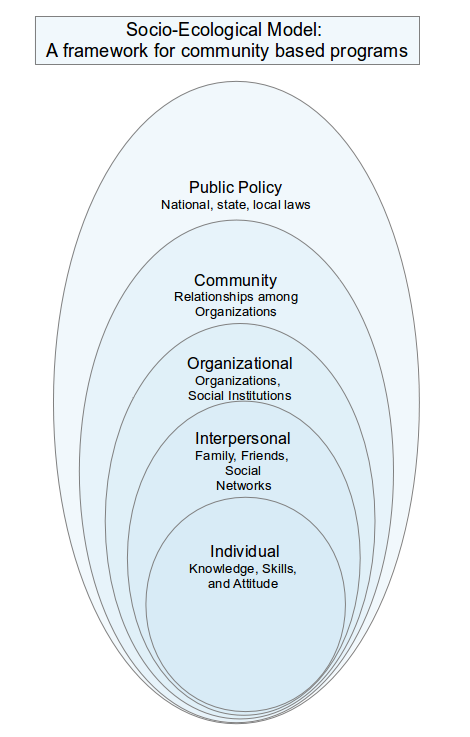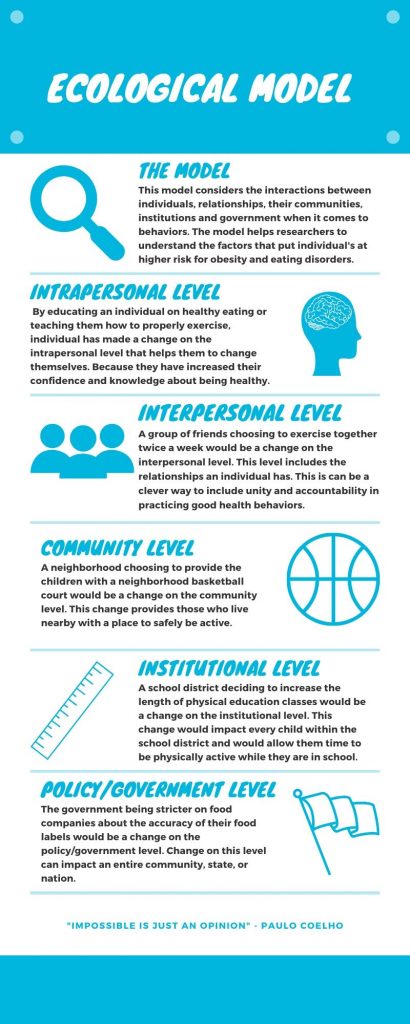1 Ecological Model
Greg Goines
Ecological Model
It is common for individuals to think their eating behaviors are strictly a personal matter, and the purpose of this textbook is to completely eliminate that notion. Behavior is influenced by more than just an individual’s perception and thoughts. When health professionals or researchers are trying to determine why individuals behave a certain way, they apply behavioral theories. Behavior is influenced by various factors, such as the individual’s relationships with others, community, job, school, and the laws that the government has put in place. One behavioral theory that encompasses all of these factors is the social-ecological model.

Intrapersonal/Individual Level

To break down the ecological model, think of throwing a rock into a lake. When the rock hits the water, concentric rings form in the water and they grow bigger the further they get away from where the rock hit. The closer the ring is to the rock, the more influence that area has on behavior change. The impact forms five rings around the rock that increase in size the further it gets away from the impact point. The first and smallest ring would be the intrapersonal level of the ecological model. This includes all the knowledge, attitudes, skills, and beliefs that each individual possesses (Healthy Campus, n.d. ). This can also include gender, economic status, age, race, ethnicity, education, genetics, and other factors that impact how individuals view themselves. Barriers that exist at this level are considered personal, for example in a study observing the barriers that prevent older adults from being physically active one of the most commonly noted barriers was physical limitations (Bethancourt et al., 2014). This is the most personal ring but the other rings are just as important.
Interpersonal Level
The second smallest ring would be considered the interpersonal level. A person’s social networks, such as family, friends, and coworkers, would be included in this level (Healthy Campus, n.d.). The people that individuals surround themselves with may influence them whether they are aware of it or not. For example, most children aren’t able to provide their own food, so their eating habits are a reflection of those that provide the food for them (Lynch & Batal, 2011). Most celebrations, i.e. a wedding, birthday party, or Thanksgiving dinner, cause the participants to eat according to the social occasion, not the level of current hunger. Today’s culture strongly associates the over-consumption of food with celebrations (Lynch & Batal, 2011). Even though eating is an individual choice, social and environmental cues can affect one’s behavior.
Community Level
Next, the third and middle ring is the community level. A community includes neighborhoods, nearby businesses, the built environment, and local infrastructure. In some scenarios, an individual wants to change but their community doesn’t enable that change due to lack of availability and safety concerns. In a study looking at the barriers that prevent children in low-income areas from being active, they had the children take pictures of their barriers. The results showed that many of the barriers occurred at the community level, such as not having a sidewalk to walk on or recreational areas not being maintained (Nichols et al., 2016). Changing behavior is hard to do when the environment around an individual does not provide the necessary resources.
Institutional Level
The fourth-largest ring would be the institutional level. This level includes jobs, schools, or organizations. The decisions that organizations and schools make can dictate what their members can or cannot do and is out of an individual’s control. Therefore, the results may positively and negatively impact different groups. For example, school districts may decide to cut physical education from the curriculum. Nearly ten percent of middle schools in the US provided the recommended amount of daily, or weekly physical activity in school, which is sixty minutes or 225 minutes per week (Erfle & Gamble, 2015). This means that the majority of the time the students spend at the school is spent being sedentary. Lack of physical activity is strongly correlated with weight gain (Erfle & Gamble, 2015). Overweight children are more likely to be obese adults and have an increased risk of developing health conditions (Erfle & Gamble, 2015). Schools are supposed to equip the students with tools to be successful in life, but by limiting the amount of physical activity in school, they are putting students at a lifelong disadvantage.
Policy/ Government Level
Lastly, the largest and outermost ring would be the policy level. This level includes local, state, national, and global laws. Elected officials make decisions that can either provide aid in an individual’s quest to change or inhibit one’s ability to change. Instances of government intervention can include regulations that provide clear and understandable food labels as well as requiring that restaurants provide accurate calculations of the number of calories in their foods.
Summary
As shown in the infographic below, all of these levels interact with each other and they can shape or create eating habits. So when a person decides to make a change, it is important to understand the impact of every level of the ecological model. Therefore, the individual should understand what resources may be available to them and also how to advocate for the resources they would like to see in their social and work communities. Understanding eating behaviors is important as it can aid in the prevention and/or treatment of all issues along the weight continuum from the extremely underweight through the grossly obese.

Review Questions
b. Intrapersonal, Interpersonal, Community, Institutional, Policy/Government
c. Intrapersonal, Institutional, Community, Institutional, Policy/Government
b. Intrapersonal
c. Interpersonal
b. Interpersonal
c. Community
References
Bethancourt, H. J., Rosenberg, D. E., Beatty, T., & Arterburn, D. E. (2014). Barriers to and facilitators of physical activity program use among older adults. Clinical Medicine & Research, 12(1–2), 10–20. https://doi-org.libproxy.clemson.edu/10.3121/cmr.2013.1171.
Erfle, S. E., & Gamble, A. (2015). Effects of daily physical education on physical fitness and weight status in middle school adolescents. Journal of School Health, 85(1), 27–35. https://doi-org.libproxy.clemson.edu/10.1111/josh.12217
Haardörfer, R., Alcantara, I., Addison, A., Glanz, K., & Kegler, M. C. (2016). The impact of home, work, and church environments on fat intake over time among rural residents: a longitudinal observational study. BMC Public Health, 16(1), 1–12. https://doi-org.libproxy.clemson.edu/10.1186/s12889-016-2764-z
Healthy Campus. (n.d.). Ecological Model. American College Health Association. https://www.acha.org/HealthyCampus/HealthyCampus/Ecological_Model.aspx.
Lynch, M., & Batal, M. (2011). Factors influencing child care providers’ food and mealtime decisions: An ecological approach. Child Care in Practice, 17(2), 185–203. https://doi-org.libproxy.clemson.edu/10.1080/13575279.2010.541424.
Nichols, M., Nemeth, L. S. , Magwood, G., Odulana, A. & Newman, S. (2016). Exploring the contextual factors of adolescent obesity in an underserved population through photovoice. Family & Community Health, 39(4), 301–309. doi: 10.1097/FCH.0000000000000118.
A theory based framework for understanding, exploring, and addressing social determinants of health at many levels
https://www.healthyteennetwork.org/wp-content/uploads/2015/06/TipSheet_IncreasingOurImpactUsingSocial-EcologicalApproach.pdf
occurring within the individual mind or self
being, relating to, or involving relations between persons
a group of people with a common characteristic or interest living together within a larger society
an established organization or corporation (such as a bank or university) especially of a public character
a high-level overall plan embracing the general goals and acceptable procedures especially of a governmental body

